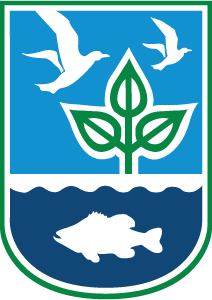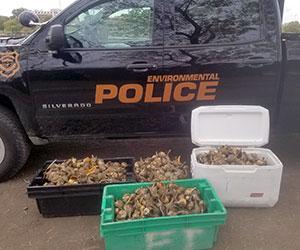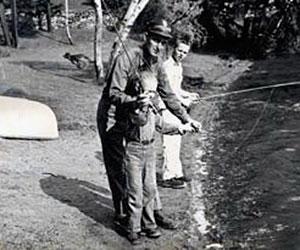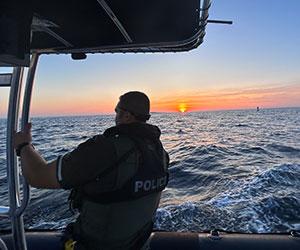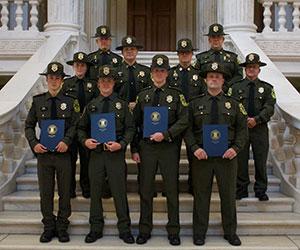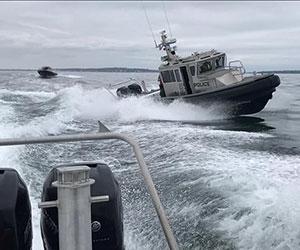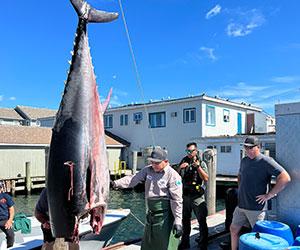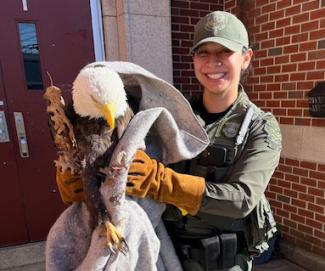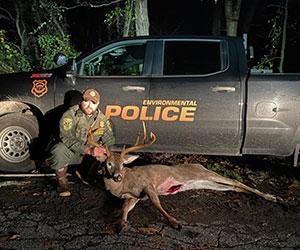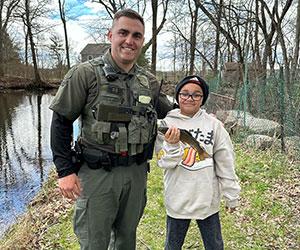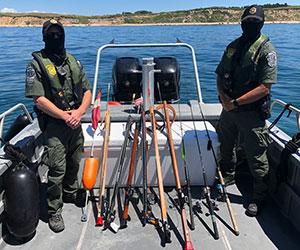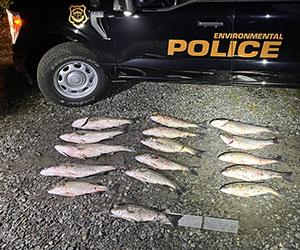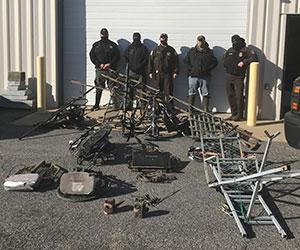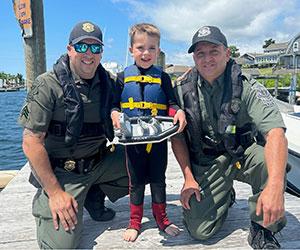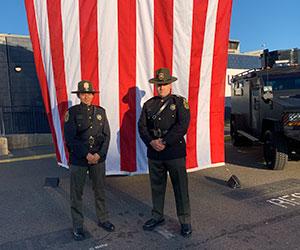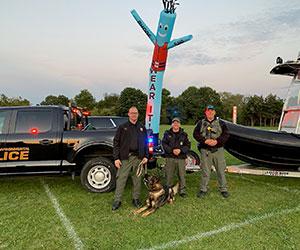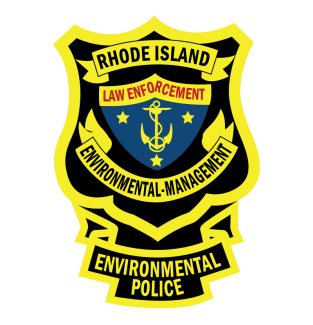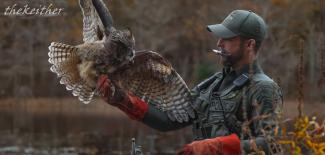
Division of Law Enforcement
About DEM's Division of Law Enforcement
The mission of the Division of Law Enforcement (DLE) is to protect the natural resources of The State of Rhode Island and to ensure compliance with all environmental conservation laws through law enforcement and education. DEM Environmental Police Officers are dedicated to this mission and value the role that they play each day in serving the State of Rhode Island, protecting its natural resources, promoting safe outdoor activities, and maintaining public safety and positive relationships with the public, all while honoring the sacred public trust.
Quick Links
- Boating Safety Certification
- Boating Safety Card Replacement Request
- Boat Accident Report Form
- Records and Day Logs
- Become an RI Environmental Police Officer
- Hunting and Recreational Fishing Licenses/Permits
- Wildlife Clinic of RI
- Learn about RI wildlife
- DEM Rules & Regulations
- RI General Laws
- Municipal Ordinances
Protecting Rhode Island’s Natural Resources—From Coast to Forest
DLE's specialized units work together to enforce environmental laws, protect our natural resources, and serve the public. While each unit has distinct responsibilities, all officers are cross-trained and support the full range of duties as needed. This integrated approach ensures a flexible, responsive force capable of addressing environmental challenges across land and water, enforcing state and federal regulations, investigating environmental crimes, and engaging with the community through education and outreach.
Marine Officers
Marine Officers play a critical role in safeguarding Rhode Island’s coastal and marine environments. They patrol state parks, shoreline areas, Narragansett Bay, and Rhode Island Sound by boat, patrol vehicle, all-terrain vehicle, and on foot.
Learn more about DLE's Marine Unit
Upland Officers
Upland officers serve across Rhode Island’s inland areas, enforcing freshwater fishing and hunting regulations and conducting investigations into hunting and inland boating accidents. Their duties extend to responding to suspected rabies cases, assisting wildlife in distress, and leading inland search and rescue operations.
Learn more about DLE's Upland Unit
Investigation, Response
The Criminal Investigation and Response Unit enforces Rhode Island’s environmental laws, focusing on hazardous and solid waste violations, water pollution, and fraudulent boat registrations. Investigators use interviews, surveillance, and other investigative techniques to identify and charge violators.
Learn more about DLE's Criminal Investigation and Response Unit
Outreach and Education
All officers play an active role in public outreach and education, both on and off patrol. In addition to engaging with the public in the field, officers participate in community events, mentor youth hunters and anglers, and teach hunter education courses.
Learn about DLE Outreach
DEM DLE Dispatch: The Critical Link in Environmental Law Enforcement
24/7 Communication, Coordination, and Support for Emergency and Non-Emergency Response Statewide
DLE Dispatchers are the vital first point of contact in emergency response, relying on strong communication skills and swift decision-making to coordinate timely and effective actions. Well-versed in law enforcement protocols, they operate complex communication systems that link multiple agencies, including the Rhode Island State Police, State Fire Marshal, NOAA/NMFS, municipal police and fire departments, and others. Dispatchers manage a broad range of responsibilities—from urgent law enforcement incidents to community service requests—ensuring public safety through precise coordination, information sharing, and unwavering situational awareness.
RI DEM DLE Dispatchers exercise strong communication skills and decision-making abilities in emergency situations. They draw upon their in-depth knowledge of law enforcement protocols and procedures to effectively operate communication systems across multiple agencies such as RI State Police, RI State Fire Marshall, NOAA/NMFS, DOH, Metro Control, Attorney General's Office, local police and fire departments, and others. Dispatchers’ attention to detail and excellent coordination skills enables them to distribute resources and response efforts effectively to various situations. Familiarity with relevant databases and systems allows Dispatchers to access and disseminate pertinent information to officers in the field.
Balancing a broad range of responsibilities, DEM DLE Dispatchers are available 24/7/365, processing both emergency and non-emergency calls for service. There is a heavy focus on violations of the law within the Department’s authority, but Dispatchers also field and collect calls regarding non-emergency circumstances, process walk-in complaints, and service requests.
Key Responsibilities:
- Answer emergency and non-emergency calls 24/7/365, focusing on law violations within the Department's authority.
- Coordinate resources effectively for various situations.
- Use databases to access and share important information with officers.
- Handle walk-in complaints and service requests.
Seasonal Safety Reminder
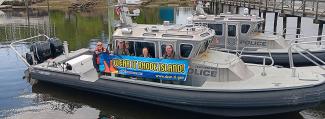
Ahoy boaters! RI Environmental Police Officers remind you to boat responsibly: stay sober, wear life jackets, and brush up on safety rules. Make sure your time on the water is full of fun, not fines. ️Visit dem.ri.gov/safeboating for more tips and resources.
Frequently Asked Questions
Yes. It is illegal to feed all wildlife in the state of Rhode Island, except for birds from suspended feeders. Feeding wildlife may lead to habituation and dangerous behavior that can endanger people and pets. No ground feeding such as throwing bread on the ground.
No. Capturing a wild animal, whether in your backyard or elsewhere, and releasing it in another location is prohibited in Rhode Island. Property owners may be inclined to offer a nuisance animal a “second chance” by live trapping it and moving it to a “new home,” but for a variety of reasons, this activity is not in the best interest of the public or wildlife.
Most situations involving nuisance wildlife can be attributed to two primary issues: food and shelter. Identifying and eliminating potential food sources, as well as preventing access to potential den sites, are the most effective ways to prevent recurring problems.
If you are experiencing a problem with wildlife, visit dem.ri.gov/wildlife for fact sheets on a variety of local wildlife species with information and advice on how to prevent or eliminate problems.
Not necessarily. Simply observing a mammal in the daytime is not a cause for concern or indicative of illness or abandonment.
Wildlife make more appearances in backyards, local parks, and sometimes unexpected areas in the springtime. Each spring, Environmental Police Officers from DEM’s Division of Law Enforcement receive many calls from concerned members of the public about “abandoned” baby wildlife. This is almost never the case. Unless a baby animal is visibly injured or in immediate danger, it should not be approached, touched, picked up, or removed from the wild.
If you observe an injured wild animal, please report it to the Wildlife Clinic of Rhode Island at 401-294-6363 for assistance or to DEM’s 24/7 dispatch at 401-222-3070.
In the uncommon instance where a wild animal is observed exhibiting symptoms of illness, such as acting strangely, the public should report it to their local animal control officer or DEM and keep their distance.
RIDOH and DEM tips for preventing rabies:
- Make sure all dogs, cats, and ferrets are up to date on rabies vaccination (as required by state law). View rabies vaccination clinics.
- All pets should be kept indoors unless supervised. Any contact between a domestic animal and wild mammal should be reported to your veterinarian and local animal control officer.
- Although most livestock are not required to be vaccinated for rabies, DEM and RIDOH strongly recommend that livestock owners consult with their veterinarian to vaccinate their animals.
- Avoid all contact with and do not feed stray or free-roaming domestic animals.
- Avoid all contact with and do not feed wild animals. Feeding wildlife is illegal in Rhode Island not only because it increases the risk of disease, but it can also lead to conflicts between humans and wildlife, and lead to unsustainable populations of wildlife.
- Do not feed your pets outdoors, as this will attract other animals. This is especially dangerous when feeding large numbers of free-roaming cats.
- Protect your pets by always maintaining control. Walk dogs on a leash or let them play in a fenced yard, and do not let pets wander unsupervised.
- Report all animal bites to your city/town's animal control officer.
- Securely cover all garbage cans so wild animals cannot scavenge for food.
- Bat-proof your house.
For more information on how to prevent rabies, please visit RIDOH’s website. For more information on rabies and ways to protect yourself and your pets, please see this RIDOH fact sheet.
Although Rhode Island is the smallest state, it has the third-highest population density in the country, with an average of 1,022 people per square mile. This has a drastic impact on Rhode Island’s wildlife, as many species see their habitats disappear, along with the food sources and resources they need to survive.
As safe places to settle become scarcer, wildlife is forced to find homes in commercial structures, leading to an increase in sightings of these animals. Predator species such as the Eastern coyote (Canis latrans), red fox (Vulpes Vulpes), North American bobcat (Lynx rufus), black bear (Ursus americanus), and more, have been known to be sighted in areas with a lot of human activity.
There are coyotes in every city and town in Rhode Island except on Block Island. Daytime activity is not a definite indication that a coyote has rabies. Coyotes are commonly active during the day, searching for food, especially when they have pups to feed in the spring. Other behavioral signs may indicate a coyote is sick. Abnormal behaviors might include erratic movements, shaking, stumbling, moving sluggishly or lethargically, or acting aggressively towards people or pets.
It is impossible to determine if an animal is rabid solely by looking at it, but if you observe a wild animal exhibiting these behaviors, report it to your local animal control officer and maintain a safe distance. Vector species for rabies in Rhode Island include bats, racoons, woodchucks, skunks, and foxes, but can be carried by any other mammal. Anyone who has had a potential rabies exposure is urged to call RIDOH’s Center for Acute Infectious Disease Epidemiology at 401-222-2577 (Monday through Friday, 8:30 AM-4:30 PM) or 401-276-8046 after hours for treatment guidance.
For wildlife questions, call RIDEM Division of Fish & Wildlife (401-789-0281), or to report emergencies, contact RI Environmental Police at 401-222-3070.
Wildlife-vehicle collisions increase seasonally as animals move more. DEM Environmental Police and seasonal staff respond as resources allow to pick up deceased deer, although some carcasses can’t be safely removed due to the location. RIDOT handles removals on highways and medians.
Rhode Island allows for the salvage of certain wildlife killed as a result of a collision with a motor vehicle per Rules and Regulations Governing the Salvaging of Wildlife that Collided with Vehicles (250-RICR-60-00-14). Reporting roadkill mortalities provides DEM Division of Fish & Wildlife (DFW) information on wildlife populations and informs efforts to prevent wildlife losses and make highways safer. Learn more about Salvage Permits for Vehicle-Killed Wildlife
The hunting and fishing abstracts are magazines with summaries of rules, regulations, seasons, and possession limits for current Rhode Island hunting, trapping, and recreational fishing seasons. Printed copies of the magazines can be found at authorized fishing and hunting license vendors, libraries, bait and tackle shops, and other outdoor gear supply stores, as well as DEM's Boating and Licensing Office in Providence and DEM's Marine Fisheries and Fish and Wildlife Offices.
View printable abstracts:
- RI Freshwater Fishing Regulation Guide
- RI Saltwater Fishing Regulation Guide
- RI Hunting & Trapping Regulations Guide
Regulations:
- Hunting Regulations for the Season (250-RICR-60-00-9)
- Fishing Regulations for the Season (250-RICR-60-00-10)
- Trout Conservation Stamp Regulations (250-RICR-60-00-5)
- Falconry Regulations for the Season (250-RICR-60-00-7)
- Rules and Regulations Governing the Importation, Feeding, and Baiting of Cervids in Rhode Island (250-RICR-60-00-2)
- Rules and Regulations Governing Collector's Permits (250-RICR-60-00-4)
All users of State Management Areas and designated undeveloped State Parks, including but not limited to: hikers, bikers, and horseback riders, are required to wear 200 square inches of solid daylight fluorescent orange from the second Saturday in September to the last day of February and the third Saturday in April to the last day in May.
Solid fluorescent hunter orange must be worn above the waist and be visible in all directions. Examples are: a hat that covers 200 square inches or a combination of hat and vest covering 500 square inches. Fluorescent camouflage does not meet this requirement.
Additional Details:
- 200 sq. in. by small game hunters during the small game season, fall turkey hunters while traveling, and muzzleloader deer hunters during the muzzleloader deer season.
- 200 sq. in. by archers when traveling to/from elevated stands during the muzzleloader season. Once in an elevated stand, archery deer hunters are exempt from the orange requirement during the muzzleloader season.
- 500 sq. in. by all hunters (including archers) and all users of management areas and undeveloped state parks during all portions of shotgun deer seasons.
- Hunters using pop-up blinds during the firearms deer season must display 200 square inches of fluorescent orange visible on the outside of the blind from all directions. Hunters must also wear orange in accordance with the rules for the specific seasons while in the blind.
- Exemptions: Raccoon hunters when hunting at night, crow hunters while hunting over decoys, spring turkey hunters, first segment dove hunters, and waterfowl hunters while hunting from a boat or a blind, over water or field, when done in conjunction with decoys. Fluorescent orange is not required in areas limited to archery-only hunting by regulation.
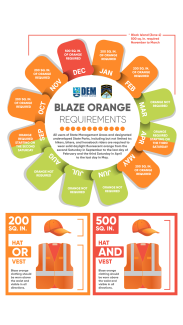
Policies & Application Forms
Additional Resources
- RI Derelict & Abandoned Vessel and Obstruction Removal
- Boat, ATV, Snowmobile Registration
- Marine Pumpouts
- Hunting & Fishing Licenses
- Management Area Maps & Hunting Resources
- Beach Water Quality Closures
- Blue-Green Algae (Cyanobacteria) Advisories
- Ice Safety Information
- Outdoor Safety Tips
- DEM Division of Fish & Wildlife
- DEM Division of Marine Fisheries
- DEM Division of Parks & Recreation
- Wildlife Clinic of RI
- Report Trout Fishing Violation
- Report an Environmental Complaint to DEM
